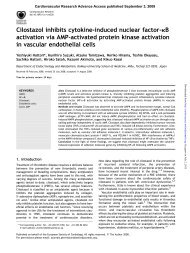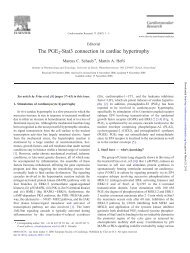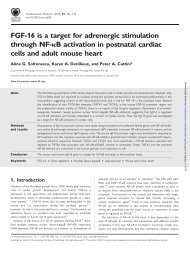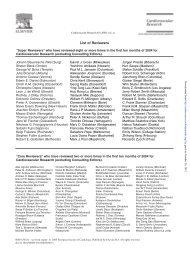Treatment with atorvastatin partially protects the rat heart from ...
Treatment with atorvastatin partially protects the rat heart from ...
Treatment with atorvastatin partially protects the rat heart from ...
- No tags were found...
Create successful ePaper yourself
Turn your PDF publications into a flip-book with our unique Google optimized e-Paper software.
Anti-adrenergic effect of <strong>atorvastatin</strong> 103<br />
Figure 2 Cardiac hypertrophy. (A) Heart-to-body weight <strong>rat</strong>io in <strong>rat</strong>s treated<br />
for 14 days <strong>with</strong> water or <strong>atorvastatin</strong> and, in addition, <strong>with</strong> a 4 day infusion<br />
of NaCl or isoprenaline (ISO). (B) Transcript levels of atrial natriuretic peptide<br />
(ANP) in left ventricular tissue of treated groups. The mean in <strong>the</strong> NaCl-H2O<br />
group was set to 1. GAPDH expression was similar in all groups. Number in<br />
columns is equal to number of animals studied.<br />
desensitization in terms of efficacy and potency. Pretreatment<br />
<strong>with</strong> <strong>atorvastatin</strong> <strong>partially</strong> prevented <strong>the</strong> ISOinduced<br />
loss of inotropic response as indicated by a slightly<br />
larger inotropic effect (Figure 3D, compare triangular to<br />
spherical symbols). The maximal inotropic response to isoprenaline<br />
was 24 and 32% higher in <strong>the</strong> low and high dose<br />
<strong>atorvastatin</strong>-treated groups, respectively, than in <strong>the</strong><br />
water group. In o<strong>the</strong>r words, <strong>the</strong> desensitizing effect of<br />
ISO amounted to 47% in <strong>the</strong> water, 30% in <strong>the</strong> low, and 28%<br />
in <strong>the</strong> high dose group.<br />
3.5 Atorvastatin did not affect total b-AR density,<br />
but reduced membrane localization of G proteins<br />
Infusion of ISO resulted in a reduction of total b-AR density<br />
by 37% (36 + 8, n ¼ 13, vs. 56 + 8 fmol/mg protein in<br />
NaCl/water, n ¼ 13). Atorvastatin pre-treatment alone did<br />
not change b-AR density (50 + 8 fmol/mg protein in<br />
NaCl/Ator low, n ¼ 13; 60 + 10 fmol/mg protein in<br />
NaCl/Ator high, n ¼ 13) nor its downregulation by ISO<br />
(36 + 6 fmol/mg protein in ISO/Ator low, n ¼ 13; 40 +<br />
7 fmol/mg protein in ISO/Ator high, n ¼ 13). However,<br />
<strong>atorvastatin</strong> pre-treatment was associated <strong>with</strong> a decrease<br />
of <strong>the</strong> membrane content of Ga s (long and short form) by<br />
4% (n.s.) and 37% at low and high doses, respectively<br />
(Figure 4B). Accordingly, Ga s in <strong>the</strong> cytosolic fraction was<br />
increased (Figure 4A). Nei<strong>the</strong>r high nor low dose <strong>atorvastatin</strong><br />
administ<strong>rat</strong>ion affected Gb distribution (Figure 4C and<br />
D). Gg 3 was detectable in <strong>the</strong> membrane fraction <strong>with</strong> an<br />
apparent weight of 10 kDa, but was undetectable in <strong>the</strong><br />
cytosolic fraction. Atorvastatin treatment dose-dependently<br />
induced a reduction in Gg 3 membrane content by 24% and<br />
50% in <strong>the</strong> low and high dose group, respectively<br />
(Figure 4E). Similar changes were seen in animals treated<br />
by <strong>atorvastatin</strong> and ISO infusion (Figure 4F). Ga i2 protein<br />
levels were not affected by <strong>atorvastatin</strong> (data not shown).<br />
4. Discussion<br />
The present study aimed at evaluating potential antiadrenergic<br />
effects of <strong>atorvastatin</strong> in <strong>rat</strong>s. Oral treatment<br />
<strong>with</strong> <strong>atorvastatin</strong> for 14 days induced partial drop-out of<br />
Gg3 and Gas <strong>from</strong> cardiac membranes. This was associated<br />
<strong>with</strong> a 10% reduction of <strong>the</strong> maximal inotropic effect of<br />
b-AR stimulation in isolated left atria and partial prevention<br />
of <strong>the</strong> desensitizing, hypertrophic, and ANP-increasing<br />
effects of chronic ISO infusion.<br />
The overall effect size was small. This may be related to<br />
dosing of <strong>atorvastatin</strong>. Compared to o<strong>the</strong>r studies <strong>with</strong> <strong>atorvastatin</strong><br />
(using doses between 2 and 50 mg/kg day in <strong>rat</strong>s),<br />
<strong>the</strong> two doses of 1 and 10 mg/kg day can be considered as<br />
low and mode<strong>rat</strong>e. Atorvastatin or water was given by daily<br />
gavage, excluding problems of drug intake via <strong>the</strong> food.<br />
Analysis of <strong>the</strong> lipid profile by HPLC revealed no differences<br />
between <strong>the</strong> groups (data not shown). This is in accordance<br />
<strong>with</strong> previous studies showing that <strong>atorvastatin</strong> delivered to<br />
normal chow-fed <strong>rat</strong>s did not affect plasma cholesterol and<br />
lowered triglycerides only at 25 mg/day. 12 Similarly, rosuvastatin<br />
at 20 mg/kg/day did not affect <strong>the</strong> lipid profile in<br />
<strong>rat</strong>s. 13 The maximal licensed dose of <strong>atorvastatin</strong> in patients<br />
(80 mg/day 1 mg/kg day) achieves maximal plasma<br />
levels of 0.3–0.5 mM in humans, 14,15 but only 0.03 mM in<br />
<strong>rat</strong>s. 15 Thus, <strong>the</strong> high dose <strong>atorvastatin</strong> used in our study<br />
(10 mg/kg day) can be expected to achieve 0.3 mM, corresponding<br />
to <strong>the</strong> normal high dose regiment in humans. Our<br />
previous study in cultured cardiac myocytes showed that significant<br />
desensitization started between 0.1 and 1 mM. 6<br />
Thus, <strong>the</strong> mode<strong>rat</strong>e effect size seen in this study appears<br />
realistic.<br />
<strong>Treatment</strong> <strong>with</strong> <strong>atorvastatin</strong> was not associated <strong>with</strong> a significant<br />
reduction in <strong>heart</strong> <strong>rat</strong>e. This may seem at variance<br />
to previous studies showing that statins lowered sympa<strong>the</strong>tic<br />
activity in patients <strong>with</strong> stable ischaemic <strong>heart</strong><br />
disease, 16 stroke-prone spontaneously hypertensive <strong>rat</strong>s, 17<br />
and rabbits <strong>with</strong> <strong>heart</strong> failure. 18 However, <strong>the</strong>se data were<br />
obtained in models <strong>with</strong> increased sympa<strong>the</strong>tic drive,<br />
whereas we tested <strong>atorvastatin</strong> in normal Wistar <strong>rat</strong>s.<br />
Statins may also increase cardiac parasympa<strong>the</strong>tic responsiveness.<br />
19 This mechanism is lipid-dependent and involves<br />
increased expression of acetylcholine-activated potassium<br />
channels and Ga i2. The fact that Ga i2 levels were unchanged<br />
in <strong>the</strong> <strong>heart</strong> of <strong>atorvastatin</strong>-treated <strong>rat</strong>s argues against <strong>the</strong><br />
involvement of this mechanism under our conditions. The<br />
lack of <strong>heart</strong> <strong>rat</strong>e effects suggests that <strong>the</strong> reduction in<br />
functional Gg in cardiac membranes is ei<strong>the</strong>r not relevant<br />
for <strong>the</strong> regulation of beating <strong>rat</strong>e or that Gg levels in <strong>the</strong>









